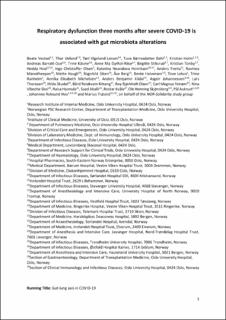| dc.contributor.author | Vestad, Beate | |
| dc.contributor.author | Ueland, Thor | |
| dc.contributor.author | Lerum, Tøri Vigeland | |
| dc.contributor.author | Dahl, Tuva Børresdatter | |
| dc.contributor.author | Holm, Kristian | |
| dc.contributor.author | Barratt-Due, Andreas | |
| dc.contributor.author | Kåsine, Trine | |
| dc.contributor.author | Dyrhol-Riise, Anne Ma | |
| dc.contributor.author | Stiksrud, Birgitte | |
| dc.contributor.author | Tonby, Kristian | |
| dc.contributor.author | Hoel, Hedda | |
| dc.contributor.author | Olsen, Inge Christoffer | |
| dc.contributor.author | Henriksen, Katerina N. | |
| dc.contributor.author | Tveita, Anders Aune | |
| dc.contributor.author | Manotheepan, Ravinea | |
| dc.contributor.author | Haugli, Mette | |
| dc.contributor.author | Eiken, Ragnhild | |
| dc.contributor.author | Berg, Åse | |
| dc.contributor.author | Halvorsen, Bente | |
| dc.contributor.author | Lekva, Tove | |
| dc.contributor.author | Ranheim, Trine | |
| dc.contributor.author | Michelsen, Annika Elisabeth | |
| dc.contributor.author | Kildal, Anders Benjamin | |
| dc.contributor.author | Johannessen, Asgeir | |
| dc.contributor.author | Thoresen, Lars | |
| dc.contributor.author | Skudal, Hilde Kristin | |
| dc.contributor.author | Kittang, Bård Reiakvam | |
| dc.contributor.author | Olsen, Roy Bjørkholt | |
| dc.contributor.author | Ystrøm, Carl Magnus | |
| dc.contributor.author | Skei, Nina Vibeche | |
| dc.contributor.author | Hannula, Raisa | |
| dc.contributor.author | Aballi, Saad | |
| dc.contributor.author | Kvåle, Reidar | |
| dc.contributor.author | Skjønsberg, Ole Henning | |
| dc.contributor.author | Aukrust, Pål | |
| dc.contributor.author | Hov, Johannes Espolin Roksund | |
| dc.contributor.author | Trøseid, Marius | |
| dc.date.accessioned | 2023-03-06T13:49:18Z | |
| dc.date.available | 2023-03-06T13:49:18Z | |
| dc.date.created | 2022-03-08T14:32:01Z | |
| dc.date.issued | 2022 | |
| dc.identifier.citation | Journal of Internal Medicine. 2022, 291 (6), 801-812. | en_US |
| dc.identifier.issn | 0954-6820 | |
| dc.identifier.uri | https://hdl.handle.net/11250/3056123 | |
| dc.description.abstract | Background - Although coronavirus disease 2019 (COVID-19) is primarily a respiratory infection, mounting evidence suggests that the gastrointestinal tract is involved in the disease, with gut barrier dysfunction and gut microbiota alterations being related to disease severity. Whether these alterations persist and are related to long-term respiratory dysfunction remains unknown.
Methods - Plasma was collected during hospital admission and after 3 months from the NOR-Solidarity trial (n = 181) and analyzed for markers of gut barrier dysfunction and inflammation. At the 3-month follow-up, pulmonary function was assessed by measuring the diffusing capacity of the lungs for carbon monoxide (DLCO). Rectal swabs for gut microbiota analyses were collected (n = 97) and analyzed by sequencing the 16S rRNA gene.
Results - Gut microbiota diversity was reduced in COVID-19 patients with respiratory dysfunction, defined as DLCO below the lower limit of normal 3 months after hospitalization. These patients also had an altered global gut microbiota composition, with reduced relative abundance of 20 bacterial taxa and increased abundance of five taxa, including Veillonella, potentially linked to fibrosis. During hospitalization, increased plasma levels of lipopolysaccharide-binding protein (LBP) were strongly associated with respiratory failure, defined as pO2/fiO2 (P/F ratio) <26.6 kPa. LBP levels remained elevated during and after hospitalization and were associated with low-grade inflammation and respiratory dysfunction after 3 months.
Conclusion - Respiratory dysfunction after COVID-19 is associated with altered gut microbiota and persistently elevated LBP levels. Our results should be regarded as hypothesis generating, pointing to a potential gut–lung axis that should be further investigated in relation to long-term pulmonary dysfunction and long COVID. | en_US |
| dc.language.iso | eng | en_US |
| dc.publisher | Wiley | en_US |
| dc.relation.uri | https://onlinelibrary.wiley.com/doi/10.1111/joim.13458 | |
| dc.title | Respiratory dysfunction three months after severe COVID-19 is associated with gut microbiota alterations | en_US |
| dc.title.alternative | Respiratory dysfunction three months after severe COVID-19 is associated with gut microbiota alterations | en_US |
| dc.type | Peer reviewed | en_US |
| dc.type | Journal article | en_US |
| dc.description.version | acceptedVersion | en_US |
| dc.source.pagenumber | 801-812 | en_US |
| dc.source.volume | 291 | en_US |
| dc.source.journal | Journal of Internal Medicine | en_US |
| dc.source.issue | 6 | en_US |
| dc.identifier.doi | 10.1111/joim.13458 | |
| dc.identifier.cristin | 2008297 | |
| dc.relation.project | Norges forskningsråd: 2021071 | en_US |
| cristin.ispublished | true | |
| cristin.fulltext | postprint | |
| cristin.qualitycode | 2 | |
